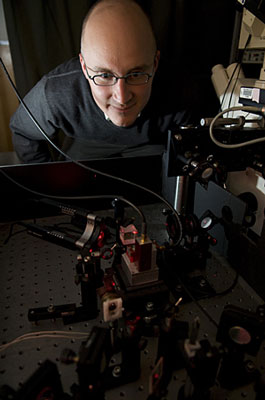| Posted: October 20, 2009 |
Two new grants to investigate directed self-assembly |
|
(Nanowerk News) Eric Furst, associate professor in the Department of Chemical Engineering at the University of Delaware, has received two grants totaling $727,000 for his work on directed self-assembly of soft materials.
|
|
The National Science Foundation (NSF) has awarded Furst $292,000 to investigate interactions and self-assembly of anisotropic colloidal particles in electric fields, while the Department of Energy (DOE) has granted him $435,000 to study directed self-assembly of nanodispersions.
|
 |
| Eric Furst
|
|
Soft materials, which are neither crystalline solids nor simple liquids but lie somewhere in between, include soaps, paints, gels, plastics, glues, and biological tissues.
|
|
“Biological systems have provided us with the inspiration to engineer modern soft materials using self-assembly,” Furst explains. “We're using the same principles to manipulate and control the interactions of colloidal particles and other building blocks so that they spontaneously organize themselves into structures that perform a desired function.”
|
|
According to Furst, directed self-assembly is especially important for the development of nanotechnology, and his two recent grants are an outgrowth of previous funding to a group of faculty in the UD Department of Chemical Engineering through NSF's Nanotechnology and Interdisciplinary Research Team (NIRT) program.
|
|
“Engineering micro- to nanoscale devices and nanostructured materials requires control and understanding of the thermodynamics and kinetics of self-assembly of nanoscale building blocks in solution,” he says.
|
|
One approach to providing that control is to use electric fields to guide the process in a particular way. The new NSF grant will support work addressing that issue, with a particular focus on unusual particles known as doublets, which resemble two spheres pushed together.
|
|
“We're interested in seeing how these particles polarize in an electric field and how their shape affects their ability to form a structure,” Furst says. “The work promises to give us new insights into directed self-assembly.”
|
|
The DOE project will be directed toward how the technology can be used to harvest soft materials for energy applications.
|

